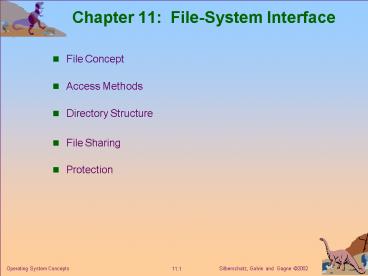Chapter 11: FileSystem Interface PowerPoint PPT Presentation
1 / 25
Title: Chapter 11: FileSystem Interface
1
Chapter 11 File-System Interface
- File Concept
- Access Methods
- Directory Structure
- File Sharing
- Protection
2
File Concept
- Contiguous logical address space
- Types
- Data
- Numeric telemetry readings
- Character - documents
- Binary images, songs, etc.
- Program
- Executable
- Dynamic libraries
3
File Structure
- Very Simple- sequence of words, bytes
- Simple record structure
- Lines
- Fixed length
- Variable length
- Complex Structures
- Formatted document Word document with OLE
- Relocatable load file- Mac forked files
- Can simulate last two with first method by
inserting appropriate control characters adding
I/O utlities. - Who decides
- Operating system
- Program development environment
4
File Attributes
- Name only information kept in human-readable
form. - Type needed for systems that support different
types. - Location pointer to file location on device.
- Size current file size.
- Protection controls who can do reading,
writing, executing. - Time, date, and user identification data for
protection, security, and usage monitoring. - Information about files (FCB) are kept in the
directory structure, which is maintained on the
disk.
5
File Operations
- Create
- Open(Fi) search the directory structure on disk
for entry Fi, and move the content of entry to
memory. - Close (Fi) move the content of entry Fi in
memory to directory structure on disk. - Delete
- Rename
- Write
- Read
- Reposition within file file seek
6
File Types Name, Extension
7
Access Methods
- Sequential Access
- read next unit of file
- write next
- reset to first unit
- no read after last write
- (rewrite)
- Direct Access
- read nth unit of file
- write nth unit of file
- position to n
- read next
- write next
- rewrite n
- n relative unit number
8
Sequential-access File
9
Example of Index Sequential Files
10
Directory Structure
- A directory is a collection of nodes containing
information about all files that have been
assigned to the directory collection.
Directory
Files
F 1
F 2
F 3
F 4
F n
Both the directory structure and the files reside
on disk. Backups of these two structures may be
kept on tapes.
11
A Complex File System Organization Logical
Partitions mapped to Physical Drives
12
Operations Performed on Directory
- Search for a file
- Create a file
- Delete a file
- List a directory
- Rename a file
- Traverse the file system
13
Organize the Directory (Logically) to Obtain
- Efficiency locating a file quickly.
- Naming convenient to users.
- Two users can have same name for different files.
- The same file can have several different names.
- Grouping logical grouping of files by
properties, - all Java programs,
- all games,
- All system files
- All project files
14
Single-Level Directory
- A single directory for all users.
Naming problem Grouping problem
15
Two-Level Directory
- Separate directory for each user.
- Path name
- same file name for different users, .login for
UNIX - Efficient searching
- No grouping capability
16
Tree-Structured Directories
17
Tree-Structured Directories (Cont.)
- Efficient searching
- Grouping Capability
- Pathnames
- Absolute
- relative
- Current directory (working directory)
- cd /spell/mail/prog
- type list
18
Tree-Structured Directories (Cont.)
- Creating a new file is done in current directory.
- Delete a file
- rm
- Creating a new subdirectory is done in current
directory. - mkdir
- Example if in current directory /mail
- mkdir count
prog
copy
prt
exp
count
Deleting mail ? deleting the entire subtree
rooted by mail.
19
Acyclic-Graph Directories
- Have shared subdirectories and files.
20
Acyclic-Graph Directories (Cont.)
- Two different names (aliasing)
- /spell/words/list
- /dict/all
- If dict deletes list ? dangling pointer.
- Solutions
- Backpointers, so we can delete all
pointers.Variable size nodes is a problem. - Reference count solution is typical .
21
General Graph Directory
22
General Graph Directory (Cont.)
- How do we guarantee no cycles?
- Allow only links to file not subdirectories.
- Garbage collection.
- Every time a new link is added use a cycle
detectionalgorithm to determine whether it is OK.
23
File Sharing
- Sharing of files on multi-user systems is
desirable. - Sharing may be done through a protection scheme.
- On distributed systems, files may be shared
across a network. - Network File System (NFS) is a common distributed
file-sharing method.
24
Protection
- File owner/creator should be able to control
- what can be done
- And by whom
- Types of access
- Read
- Write
- Execute
- Append
- Delete
- List
25
Access Lists and Groups
- UNIX Mode of access read, write, execute
- Three classes of users
- RWX
- a) owner access 7 ? 1 1 1 RWX
- b) group access 6 ? 1 1 0
- RWX
- c) public access 1 ? 0 0 1
- Ask sysadmin to create a workgroup (unique name),
say SrProj, and add some users to the group. - For a particular file (say game) or subdirectory,
define an appropriate access.
owner
group
public
chmod
761
game
Attach a group to a file chgrp
SrProj game

